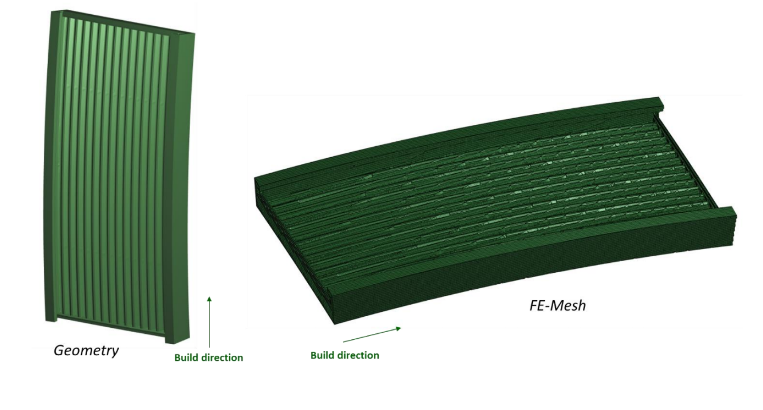In the recent ‘Numerical prediction of distortion. Benchmarking of Additive Works Amphion against real AM component,’ authors Nils Keller and Michal Prugarewicz explore how far metal 3D printing has come. Looking back on a project in 2015, the authors explain that the first pre-serial, completely 3D printed gas turbine part was fabricated and released. Meant for commercial use, manufacturing of this part also meant validation of AM powder technology for an industrial gas turbine.
Researchers continued to work on the design, and it evolved over time—so far as to be installed in machinery for a customer; however, issues with distortion continued to be a problem and project managers realized a solution would be required for ultimate success in production. What was needed was a method for controlling distortion while engineers were involved in the build process.
While an application with a nickel-based superalloy Inconel IN738 was considered a ‘main point of interest’ for both validation and development, the project team discovered it to be the most challenging issue due the greatest amount of deformation. There was no suitable software for dealing with these issues such as offering simulation exercises; however, the project team was able to create a standard FE software, and scanning was successful afterward. Now, for 2019, the software offers a choice for simulation during the build process, along with a way to ‘compensate distortion of AM components.’
One part of this project also involved ‘benchmarking’ the Additive Works Amphyon, centered around developing the turbine component and better performance in the software. A 3D printed generic model was created, as the project team relied on dimensions from an ‘ex-service part.’ They were able to reverse engineer the design of a part used and then removed in 2016, with mechanical properties based on previous research and writing regarding material behavior.
In this study, applied strain @RT was set up to 1100 MPa and 1.487 % respectively, with the expectation that temperature would not increase substantially while printing.
A focus on temperatures helped derive strategies for thermal stability as the researchers assessed the position and design of support structures, distortion, and places that could lead to damage. Calculations were made using Amphyon software, with comparisons between both nominal and distorted models.
“Compensation of distortion can be done automatically in Amphyon with reversed values,” explained the researchers. “Shape of distortion and a value of distortion is in line of experience with same order of magnitude.”
During the second assessment, the project team created a simple DOE for displaying distortion deviation due to scatter of material properties, modifying yield stress (YS) and strains (EPS). Ultimately, because of the ‘complexity of assessment,’ the researchers recommended good cooperation between those involved such as designers, engineers, and material science and manufacturing specialists.
“A numerical approach of prediction of distortion may lead to a significant reduction of design concepts and try-error manufacturing approaches which control costs and lead-time of development of additively manufactured parts and therefore [are] recommended to be performed,” concluded the researchers.
Researchers continue to explore better ways to 3D print in metal, as well as improve mechanical properties from alloys, to shape memory, to innovative composites, and more.
What do you think of this news? Let us know your thoughts; join the discussion of this and other 3D printing topics at 3DPrintBoard.com.
[Source / Images: ‘Numerical prediction of distortion. Benchmarking of Additive Works Amphyon against real AM component’]Subscribe to Our Email Newsletter
Stay up-to-date on all the latest news from the 3D printing industry and receive information and offers from third party vendors.
You May Also Like
Printing Money Episode 17: Recent 3D Printing Deals, with Alex Kingsbury
Printing Money is back with Episode 17! Our host, NewCap Partners‘ Danny Piper, is joined by Alex Kingsbury for this episode, so you can prepare yourself for smart coverage laced...
Insights from Cantor Fitzgerald on AM’s Q1 2024 Landscape
A recent survey by Cantor Fitzgerald sheds light on the persistent challenges within the additive manufacturing (AM) industry in the first quarter of 2024. Based on responses from 38 industry...
3D Printing Financials: Xometry’s Scaling up and Strong Start to 2024
Xometry (Nasdaq: XMTR) kicked off 2024 with strong results, boosting its marketplace and technology to new heights. Both revenue and gross margin soared, fueled by an expanding global network of...
3D Printing Financials: Desktop Metal Targets Recovery Amid Net Losses and Revenue Downturn
Despite facing a decline in revenue and the persistent challenges of a tight economic climate, Desktop Metal (NYSE: DM) is making strides toward operational efficiency. The first quarter of 2024...





































